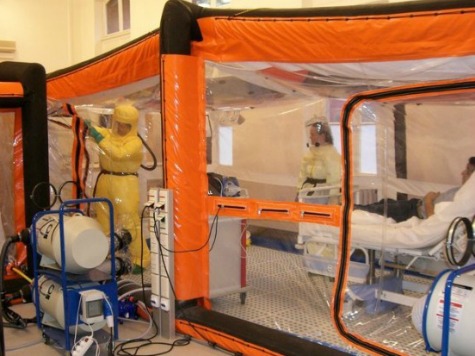
When two Christian charity workers arrived in the United States from West Africa for treatment to combat Ebola, many wondered why that transfer was chosen–and why, specifically, Emory University in Atlanta had chosen to treat them. In conversation with NPR, the director of Emory’s Serious Communicable Disease Unit explains why.
Dr. Bruce Ribner, who runs the highly technologically advanced unit in Emory’s medical center, explains to NPR a number of features that make Emory among the safest places to keep Ebola patients. The rooms in the unit are designed for easy application and removal of protective gear, so doctors can move in and out safely, while providing the necessary space required in an intensive care unit.
One of its most impressive features, Dr. Ribner explains, is the air pressure design that keeps airborne viruses out of other chambers. “The air pressure is negative so that air flows from the hallway to the anteroom to the patient room,” he explains– which, he adds, is not necessarily a benefit to keep Ebola from spreading, as scientists do not believe the virus is airborne. But the feature adds added safety, and the patient room itself– where the virus will be contained given the air pressure– receives “20 air changes per hour so that all infectious particles are rapidly removed.” Any disposable items used on patients, Dr. Ribner notes, is incinerated upon use.
Dr. Kent Brantly and Nancy Writebol, both workers for the Christian charity Samaritan’s Purse, contracted Ebola while working in Liberia. Brantly, who is recovering at a faster pace than Writebol, initially refused a dose of the experimental drug ZMapp in order for Writebol to receive it. He has since received a second dose and penned a letter from his hospital bed, saying he is regaining strength and Emory and is optimistic that he will survive.
According to the World Health Organization, Ebola can have a kill rate between 60% and 90%, but the odds of surviving increase exponentially if the patient is treated in an advanced facility. Death rates in Africa are significantly higher than they would be in areas with more medical resources, many argue, precisely because critical medical infrastructure is missing. This has prompted nations around the world to prepare Ebola-friendly facilities in the event of a traveler bringing the virus into their country. West Africa has yet to have that luxury, however; in the case of Liberia, what little medical infrastructure existed before the outbreak is now on the brink of collapse.

COMMENTS
Please let us know if you're having issues with commenting.